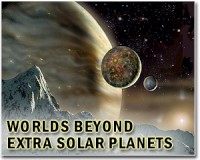| . |  |
. |
La Silla, Chile (UPI) Aug 24, 2010 European astronomers say they've discovered a planetary system with at least five and possibly seven planets, the most yet seen outside our own solar system. Scientists of the European Southern Observatory using a telescope at La Silla, Chile, found the planets orbiting a sun-like star 127 light years from earth, an ESO release said Tuesday. "We have found what is most likely the system with the most planets yet discovered," Christophe Lovis, lead author of the paper reporting the result, said. "This remarkable discovery also highlights the fact that we are now entering a new era in exoplanet research: the study of complex planetary systems and not just of individual planets." The astronomers measured tiny oscillating movements of the star caused by the complex gravitational attractions from five or more planets. The five strongest signals correspond to planets with masses similar to Neptune orbiting the star with periods ranging from about 6 to 600 days. "We also have good reasons to believe that two other planets are present," says Lovis. One is suspected to be a Saturn-like planet orbiting in 2200 days. The other is thought to be the least massive exoplanet ever discovered, with a mass of about 1.4 times that of the Earth. It is very close to its host star, at just 2 percent of the Earth-sun distance, ESO scientists say.
Share This Article With Planet Earth
Related Links Lands Beyond Beyond - extra solar planets - news and science Life Beyond Earth
 Astronomers bag biggest harvest of exoplanets
Astronomers bag biggest harvest of exoplanetsParis (AFP) Aug 24, 2010 European astronomers on Tuesday said they had found a distant star orbited by at least five planets in the biggest discovery of so-called exoplanets since the first was logged 15 years ago. The star is similar to our Sun and its planetary lineup has an intriguing parallel with own Solar System, although no clue has so far been found to suggest it could be a home from home, they said. The ... read more |
|
| The content herein, unless otherwise known to be public domain, are Copyright 1995-2010 - SpaceDaily. AFP and UPI Wire Stories are copyright Agence France-Presse and United Press International. ESA Portal Reports are copyright European Space Agency. All NASA sourced material is public domain. Additional copyrights may apply in whole or part to other bona fide parties. Advertising does not imply endorsement,agreement or approval of any opinions, statements or information provided by SpaceDaily on any Web page published or hosted by SpaceDaily. Privacy Statement |